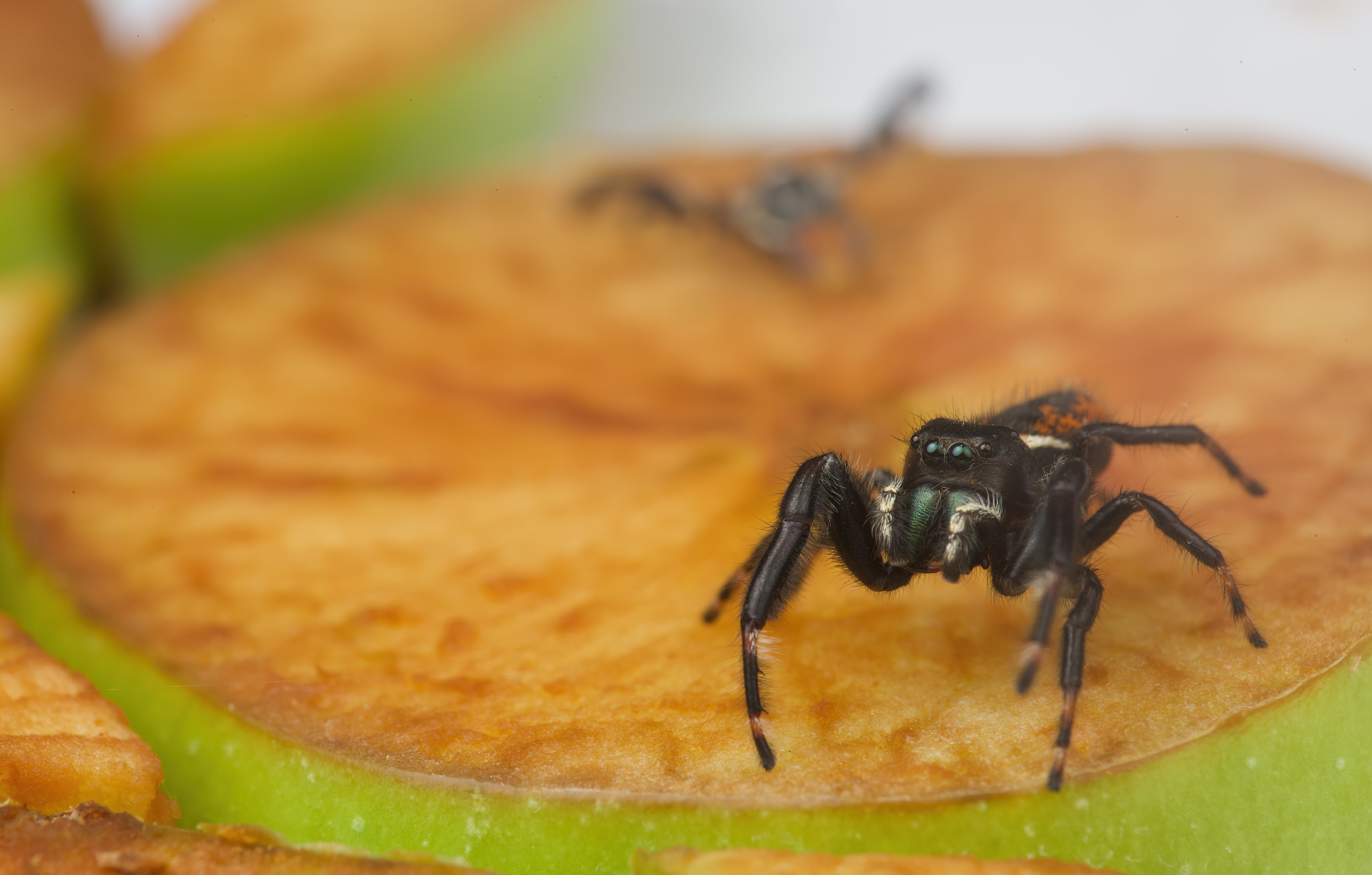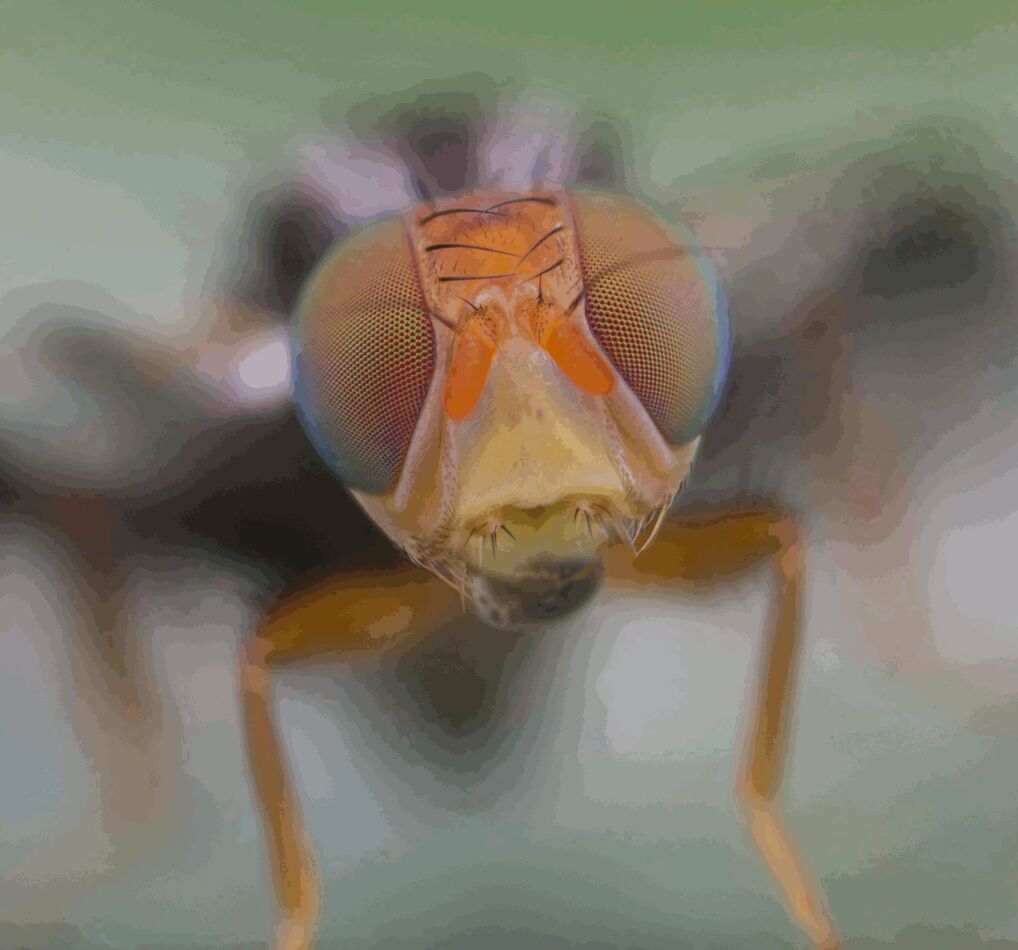The wonders of apple maggot flies
Mar 18, 2023 14:47:07 #
The name is not appealing, but apple maggot flies (Rhagoletis pomonella) are interesting for different reasons. Here is an apple maggot fly that I found hanging around our apple trees last summer. Although rather pretty, they are considered a serous pest to apples. I found that I could photograph this one very easily by simply giving it slices of apple. So while the fly is slurping up sour apple juice, allow me to tell you what I've learned about apple maggot flies.
 Apple maggot fly by Mark Sturtevant, on Flickr
Apple maggot fly by Mark Sturtevant, on Flickr
One interesting thing about them is that they are a classic example of "sympatric speciation". This form of speciation is where one species becomes two species while still living in the same area, rather than after they are separated to live in different areas. What happened to cause this in this species is the introduction of apple trees to North America. You see, their native host plant are hawthorn trees, which are related to apples. However, when European settlers brought over apple trees, some of the flies started to prefer the new trees as their host plants. This was first noted to happen by 1850. So now there are two populations of the flies, one that continues to live and breed on hawthorns (these are sometimes called hawthorn maggot flies), while the apple maggot flies prefer apple trees. Although there is considerable reproductive isolation in the wild between these populations, they are still considered one species although I am not sure why.
This sort of thing has apparently happened several times, by the way, as there are several identical-looking kinds of flies that live on native snowberries, honeysuckle, blueberries, and other fruits. Some of these are considered separate species now.
Now when this fly turns away from the camera, we see another interesting thing about them. Those bold stripes on the wings look a lot like spider legs, don’t they? A look-alike species (this one is given its own species name), was found to use this wing pattern to deliberately mimic jumping spiders, and this helps prevent attacks by those visual predators.
 Apple maggot flies are spider mimics by Mark Sturtevant, on Flickr
Apple maggot flies are spider mimics by Mark Sturtevant, on Flickr
Experiments showed that when a jumping spider approaches one of these flies, the fly is seen to turn to face its predator and spread out its wings – suddenly making them look a lot more spider-like. The spider would then frequently move away rather than attempt to have a meal. This is described in this classic paper: https://www.researchgate.net/publication/6083894_A_Sheep_in_Wolf%27s_Clothing_Tephritid_Flies_Mimic_Spider_Predators
So I set out to see if I could make this remarkable interaction happen with what I presume is an apple maggot fly.
I soon managed to find a suitable jumping spider (a male Phidippus clarus). If they were to cross paths, would the fly use its wings to mimic a jumping spider? Would the spider react as if it came upon one of its own kind? In truth, it can be hard to get animals to behave like you’d want them, but I do believe I managed to get a partial positive result.
Over several trials, with camera in hand, I arranged for the two to encounter one another. Pretty much every time … nothing happened. The fly slurped up apple juice, and the spider, while at times glancing at the fly, would simply steer around it. I don't know what that means.
But on one occasion – and I don’t know what was special about this occasion -- the fly definitely reacted to the nearby spider by suddenly snapping around to face the spider while holding out its wings. Its reaction was quick. You can see the fly in the background here, although very out of focus. The spider meanwhile seemed to not react much other than to move away.
 Apple maggot fly versus jumping spider by Mark Sturtevant, on Flickr
Apple maggot fly versus jumping spider by Mark Sturtevant, on Flickr
Here the spider had moved on, and the fly is still in its spider-mimicking pose. That was pretty cool! But I am not sure what the spider thought of it.
 Apply maggot fly versus jumping spider by Mark Sturtevant, on Flickr
Apply maggot fly versus jumping spider by Mark Sturtevant, on Flickr
I did several more trials over a few days. But I got nothing more out of either of them. But that one result was still interesting enough that I definitely would like to try this again!
 Apply maggot fly versus jumping spider by Mark Sturtevant, on Flickr
Apply maggot fly versus jumping spider by Mark Sturtevant, on Flickr
It has been proposed that this particular kind of mimicry, where insects mimic jumping spiders in order to avoid predation by them -- is rather widely seen in insects. There is this interesting paper that makes the case for this: https://peckhamia.com/peckhamia/PECKHAMIA_179.1.pdf You should scroll through and look at the fascinating pictures!
Thank you for looking! (Click Download to activate a gif animation)
 Apple maggot fly by Mark Sturtevant, on Flickr
Apple maggot fly by Mark Sturtevant, on FlickrOne interesting thing about them is that they are a classic example of "sympatric speciation". This form of speciation is where one species becomes two species while still living in the same area, rather than after they are separated to live in different areas. What happened to cause this in this species is the introduction of apple trees to North America. You see, their native host plant are hawthorn trees, which are related to apples. However, when European settlers brought over apple trees, some of the flies started to prefer the new trees as their host plants. This was first noted to happen by 1850. So now there are two populations of the flies, one that continues to live and breed on hawthorns (these are sometimes called hawthorn maggot flies), while the apple maggot flies prefer apple trees. Although there is considerable reproductive isolation in the wild between these populations, they are still considered one species although I am not sure why.
This sort of thing has apparently happened several times, by the way, as there are several identical-looking kinds of flies that live on native snowberries, honeysuckle, blueberries, and other fruits. Some of these are considered separate species now.
Now when this fly turns away from the camera, we see another interesting thing about them. Those bold stripes on the wings look a lot like spider legs, don’t they? A look-alike species (this one is given its own species name), was found to use this wing pattern to deliberately mimic jumping spiders, and this helps prevent attacks by those visual predators.
 Apple maggot flies are spider mimics by Mark Sturtevant, on Flickr
Apple maggot flies are spider mimics by Mark Sturtevant, on FlickrExperiments showed that when a jumping spider approaches one of these flies, the fly is seen to turn to face its predator and spread out its wings – suddenly making them look a lot more spider-like. The spider would then frequently move away rather than attempt to have a meal. This is described in this classic paper: https://www.researchgate.net/publication/6083894_A_Sheep_in_Wolf%27s_Clothing_Tephritid_Flies_Mimic_Spider_Predators
So I set out to see if I could make this remarkable interaction happen with what I presume is an apple maggot fly.
I soon managed to find a suitable jumping spider (a male Phidippus clarus). If they were to cross paths, would the fly use its wings to mimic a jumping spider? Would the spider react as if it came upon one of its own kind? In truth, it can be hard to get animals to behave like you’d want them, but I do believe I managed to get a partial positive result.
Over several trials, with camera in hand, I arranged for the two to encounter one another. Pretty much every time … nothing happened. The fly slurped up apple juice, and the spider, while at times glancing at the fly, would simply steer around it. I don't know what that means.
But on one occasion – and I don’t know what was special about this occasion -- the fly definitely reacted to the nearby spider by suddenly snapping around to face the spider while holding out its wings. Its reaction was quick. You can see the fly in the background here, although very out of focus. The spider meanwhile seemed to not react much other than to move away.
 Apple maggot fly versus jumping spider by Mark Sturtevant, on Flickr
Apple maggot fly versus jumping spider by Mark Sturtevant, on FlickrHere the spider had moved on, and the fly is still in its spider-mimicking pose. That was pretty cool! But I am not sure what the spider thought of it.
 Apply maggot fly versus jumping spider by Mark Sturtevant, on Flickr
Apply maggot fly versus jumping spider by Mark Sturtevant, on FlickrI did several more trials over a few days. But I got nothing more out of either of them. But that one result was still interesting enough that I definitely would like to try this again!
 Apply maggot fly versus jumping spider by Mark Sturtevant, on Flickr
Apply maggot fly versus jumping spider by Mark Sturtevant, on FlickrIt has been proposed that this particular kind of mimicry, where insects mimic jumping spiders in order to avoid predation by them -- is rather widely seen in insects. There is this interesting paper that makes the case for this: https://peckhamia.com/peckhamia/PECKHAMIA_179.1.pdf You should scroll through and look at the fascinating pictures!
Thank you for looking! (Click Download to activate a gif animation)
Mar 18, 2023 16:23:11 #
Mar 19, 2023 06:50:18 #
Mar 19, 2023 08:05:18 #
You have told and show us what sounds like science fiction, scripted evolution!! Mark, Your marvelous, intriguing, photos and research are the basis for a PhD thesis... intriguing. Mark, you have great patients and skills. Then again how could less be expected, you came from Grand Blanc, my old hometown.
Your tech photos and brief lecture have brought to mind a great movie about flies. Those who haven't seen it should watch 'The Fly.' "When scientist Seth Brundle (Jeff Goldblum) completes his teleportation device, he decides to test its abilities on himself. Unbeknownst to him, a housefly slips in during the process, leading to a merger of man and insect." Movie 1986
Your tech photos and brief lecture have brought to mind a great movie about flies. Those who haven't seen it should watch 'The Fly.' "When scientist Seth Brundle (Jeff Goldblum) completes his teleportation device, he decides to test its abilities on himself. Unbeknownst to him, a housefly slips in during the process, leading to a merger of man and insect." Movie 1986
Mar 19, 2023 10:53:31 #
Amazing, super, and a fantastic series and ever so educational. Thanks, ever so much for sharing.
Mar 19, 2023 13:00:32 #
Mar 19, 2023 13:05:52 #
Thank you, everyone! It was fun to shoot, and also fun to research.
Mar 19, 2023 13:38:52 #
If you want to reply, then register here. Registration is free and your account is created instantly, so you can post right away.







